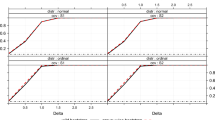Abstract
Although multidimensional scaling (MDS) profile analysis is widely used to study individual differences, there is no objective way to evaluate the statistical significance of the estimated scale values. In the present study, a resampling technique (bootstrapping) was used to construct confidence limits for scale values estimated from MDS profile analysis. These bootstrap confidence limits were used, in turn, to evaluate the significance of marker variables of the profiles. The results from analyses of both simulation data and real data suggest that the bootstrap method may be valid and may be used to evaluate hypotheses about the statistical significance of marker variables of MDS profiles.
Similar content being viewed by others
References
Borg, I., &Groenen, P. (1997).Modern multidimensional scaling: Theory and applications. New York: Springer-Verlag.
Campbell, D. P., &Hansen, J. C. (1985).Strong-Campbell interest inventory. Palo Alto, CA: Stanford University Press.
Davison, M. L. (1983).Multidimensional scaling. Malabar, FL: Krieger.
Davison, M. L. (1994). Multidimensional scaling models of personality responding. In S. Strack & M. Lorr (Eds.),Differentiating normal and abnormal personality (pp. 196–215). New York: Springer-Verlag.
Davison, M. L., Gasser, M., &Ding, S. (1996). Identifying major profile patterns in a population: An exploratory study of WAIS and GATB patterns.Psychological Assessment,8, 26–31.
Efron, B. (1979). Computers and the theory of statistics: Thinking the unthinkable.SIAM Review,21, 460–480.
Efron, B., &Tibshirani, R. J. (1993).An introduction to the bootstrap. New York: Chapman & Hall.
Fox, J. (1997).Applied regression analysis, linear models, and related methods. Thousand Oaks, CA: Sage.
Goodrum, A. A. (2001). Multidimensional scaling of video surrogates.Journal of the American Society for Information Science & Technology,52, 174–182.
Hjorth, U. (1994).Computer intensive statistical methods: Validation model selection and bootstrap. New York: Chapman & Hall.
Hogan, R. (1983). Socioanalytic theory of personality. In M. M. Page (Ed.),1982 Nebraska symposium on motivation: Personality—current theory and research (pp. 55–89). Lincoln: University of Nebraska Press.
Holland, J. L. (1973).Making vocational choices: A theory of careers. Englewood Cliffs, NJ: Prentice-Hall.
Jacobowitz, D. (1975).The acquisition of semantic structures. Unpublished doctoral dissertation, University of North Carolina, Chapel Hill.
Johnson, L. (1995). A multidimensional analysis of the vocational aspirations of college students.Measurement & Evaluation in Counseling & Development,28, 25–44.
Kruskal, J. B. (1964). Multidimensional scaling by optimizing goodness of fit to a nonmetric hypothesis.Psychometrika,29, 1–27.
McWhirter, B. T., Palombi, B., &Garbin, C. P. (2000). University employees’ perceptions of university counseling center services and consultation activities: A multidimensional scaling analysis.Journal of College Counseling,3, 142–157.
Padula, M. A., Conoley, C. W., &Garbin, C. P. (1998). The dimensions underlying loneliness counseling interventions: A multidimensional scaling solution.Journal of Counseling & Development,76, 442–451.
Prediger, D. J. (1982). Dimensions underlying Holland’s hexagon: Missing link between interests and occupations?Journal of Vocational Behavior,21, 259–287.
Ramsay, J. O. (1977). Maximum likelihood estimation in multidimensional scaling.Psychometrika,42, 241–266.
Raymond, M. R. (1989). Applications of multidimensional scaling to research in the health professions.Evaluation & the Health Professions,12, 379–408.
SAS Institute (2000).Jackboot.sas. Cary: NC: Author.
Simon, J. L., &Bruce, P. (1991). Resampling: A tool for everyday statistical work.Chance,4, 22–32.
Sireci, S. G., &Geisinger, K. F. (1992). Analyzing test content using cluster analysis and multidimensional scaling.Applied Psychological Measurement,16, 17–31.
Stine, R. (1990). An introduction to bootstrap methods: Examples and ideas. In J. Fox & J. S. Long (Eds.),Modern methods of data analysis (pp. 325–373). Newbury Park, CA: Sage.
Thomas, J. A., &Stock, W. A. (1988). The concept of happiness: A multidimensional scaling investigation.International Journal of Aging & Human Development,27, 141–154.
Tittle, C. K. (1996). Investigating the construct validity of scores from a measure of student perceptions about mathematics classroom activities using multidimensional scaling.Educational & Psychological Measurement,56, 701–709.
Tracey, T. J., &Rounds, J. B. (1993). Evaluating Holland’s and Gati’s vocational-interest models: A structural meta-analysis.Psychological Bulletin,113, 229–246.
Treat, T. A., McFall, R. M., Viken, R. J., Nosofsky, R. M., MacKay, D. B., &Kruschke, J. K. (2002). Assessing clinically relevant perceptual organization with multidimensional scaling techniques.Psychological Assessment,14, 239–252.
Weinberg, S. L., Carroll, J. D., &Cohen, H. S. (1984). Confidence regions for INDSCAL using the jackknife and bootstrap techniques.Psychometrika,49, 475–491.
Young, G. A. (1994). Bootstrap: More than a stab in the dark? [with commentary].Statistical Science,9, 382–415.
Author information
Authors and Affiliations
Corresponding author
Additional information
Note—This article was accepted by the previous editor, Jonathan Vaughan.
Rights and permissions
About this article
Cite this article
Ding, C.S. Determining the significance of scale values from multidimensional scaling profile analysis using a resampling method. Behavior Research Methods 37, 37–47 (2005). https://doi.org/10.3758/BF03206396
Received:
Accepted:
Published:
Issue Date:
DOI: https://doi.org/10.3758/BF03206396




